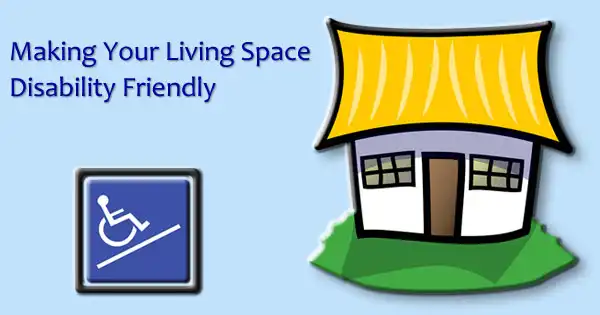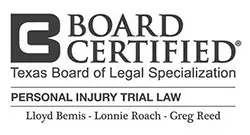Making Your Living Space Disability Friendly
If you are suffering from the effects of a disability there are ways to improve your home to help ease the challenges of your everyday life.
Author Attorney Greg Reed:
Everyone wants to live in a home that is comfortable, safe and enjoyable. For the 56.7 million people living with a disability, a dwelling must also accommodate their mobility and functional challenges in order to live a more independent life.

Whether you are moving into a new home or updating your own, if you are disabled there are a number of ways to make your living space more accommodating.
Many new homes today are built with modifications for the disabled, but most older homes are not.
Those with mobility challenges must be able to get in and out of the house, move through entrances and doorways easily, and be able to maneuver within the bathroom and kitchen.
Whether you are moving into a new home or updating your own, there are several ways to make your living space more accommodating.
As you consider changes, think about your current abilities and health and plan for the future. Over time your disability may present new challenges. You may have good days and bad days; prepare for the bad days by making daily tasks easier.
You will want to have easy access to the kitchen, bathroom, bedroom and living room, so if possible, your home should have all the rooms you use on the same floor.
Here are some ideas to make your home a place where you can function independently and make your life more pleasant and safe.
If you have been denied disability benefits don’t give up! Contact a Disability lawyer at 512-454-4000 for a free consultation and get the benefits you deserve.
The exterior of the home:
- The address should be easily visible from the street in the dark or during bad weather. House numbers should be reflective, at least 3 inches tall, and securely fixed to the building.
- Walkways should be level and easily navigated by wheelchair or walker with no cracks in the sidewalk. Pathways should be constructed of a textured material to prevent slippage. It is also a good idea to keep snowmelt material handy.
- Install light/motion sensors to create a well-lit path as well as an added security measure.
- Place a bench or shelf near the entrance to hold packages and bags while unlocking the door.
- Move the mailbox to an accessible location.
- The front door should have a peep hole at your eye level.
The kitchen should be arranged to accommodate any mobility or functional impairments.
- A kitchen should have at least one workspace that is accessible while sitting. This could be a table, a fold-out table securely fastened to the wall, or even a cutting board that can be pulled out from a countertop.
- The sink should also be accessible while sitting and have a spray hose that can be used to rinse dishes. Cabinets can be removed so that you can sit with your legs under the sink, but be sure to cover exposed pipes to prevent burning your legs.
- Stove controls should be located on the front of the appliance with 2 feet of counterspace to one side to allow sliding hot utensils off the burner.
- Use glass cookware to watch cooking food.
- Install pull-out shelves and keep any utensils and dishes used regularly on lower shelves.
- Lazy susans can be placed in refrigerators and cabinets to access food. Keep a barbeque tong handy to grab items that are hard to reach.
Bathroom:
- Install grab bars in the tub, shower and toilet areas. Make sure they are securely installed to support your weight. The grab bars should have some texture so they are easy to hold on to when wet.
- Instead of shower doors, install a shower curtain.
- Place a non-slip mat and seat in the shower/tub area. Bathmats outside the shower should also be non-slip.
- A countertop sink is the best option, securely installed with “L” brackets so you can lean on it.
- Lower the medicine cabinet and mirror and install wire racks and pull out shelves for storage.
Living Room, bedroom and hallways:
- Tile and laminate are best for flooring, but any carpeting should allow a wheelchair to move over it.
- Rugs should be secured so they don’t slip.
- Tuck electrical wires behind furniture or mount on baseboards.
- Space furniture so it is easy for you to move around and pad any sharp corners on tables, chairs and bed frames.
- Use a smaller bed, or push the bed against the wall to allow more room to move around.
- Install a grab bar near the bed so it is easy to get in and out.
- If you have a landline phone, keep it reachable, as on a bedside table; make sure there is an outlet near the bed for easy charging to your cell phone.
- Install light switches at each end of hallways and staircases to keep them well lit.
- Replace door knobs with handles.
Some of these suggestions are simpler to implement than others.
Always consult a reputable professional before making any major changes to your living space, especially when installing grab bars or mounting furniture to the wall. Even with just a few practical updates, you can transform your home into a pleasing, more functional dwelling, improving the safety and enhancing the enjoyment of your daily life.
Disability benefits are an important source of income for those who are unable to work. If you not able to work due to accident or illness, you may be eligible for Social Security Disability or Long Term Disability benefits. If you have applied for benefits and been denied, contact the attorneys at Bemis, Roach and Reed for a free consultation. Call 512-454-4000 and get help NOW.
Helpful Assistance Programs and Resources for the Disabled
New Year’s Resolutions for the Disabled
How will the GOP Tax Plan Affect the Disabled?
Author: Attorney Greg Reed has been practicing law for 29 years. He is Superlawyers rated by Thomson Reuters and is Top AV Preeminent® and Client Champion Gold rated by Martindale Hubbell. Through his extensive litigation Mr. Reed obtained board certification from the Texas Board of Legal Specialization. Greg is admitted to practice in the United States District Court - all Texas Districts and the United States Court of Appeals-Fifth Circuit. Mr. Reed is a member of the Travis County Bar Association, Texas Trial Lawyers Association, past Director of the Capital Area Trial Lawyers Association, and an Associate member of the American Board of Trial Advocates. Mr. Reed and all the members of Bemis, Roach & Reed have been active participants in the Travis County Lawyer referral service.
Your Free Initial Consultation
Call now:
At Bemis, Roach and Reed, if we can't help you, we will try to find the right attorneys for you.
We offer each of our prospective clients a free no obligation one hour phone or office consultation to see if we can help you and if you are comfortable with us. We know how difficult a time like this can be and how hard the decisions are. If we can be of assistance to you and help you find a solution to your issue we will even if that means referring you to another attorney.
Let's get you Started:
If you could provide us with some basic information about your claim we will get right back with you with a free case evaluation and schedule your Free Consultation Today.








